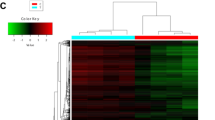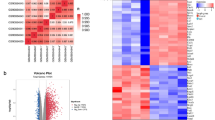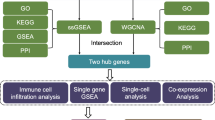Abstract
Objectives:
This study was designed to explore the molecular mechanisms of spinal cord injury (SCI) with time.
Methods:
The gene expression profile (GSE45006) including four non-injured spinal cord samples as sham-control group and 20 thoracic transected spinal cords samples as experimental group at different times was downloaded from Gene Expression Omnibus database. The time-course changes of the SCI-related differentially expressed genes (DEGs) were identified. In addition, time-series expression profile clusters of DEGs were obtained, followed by gene ontology (GO) and pathway enrichment analysis of the DEGs. Moreover, the transcriptional regulatory network was constructed.
Results:
There were 1420, 492, 743, 568 and 533 DEGs respectively at d1, d3, w1, w2 and w8 compared with that of sham group. Importantly, 101 overlapped regulated DEGs were identified at five time points and 370 collaboratively regulated genes were identified in cluster 6. Significant functions of overlapped regulated DEGs were obtained including response to wounding and developmental process. In addition, the DEGs, such as CD14 molecule (CD14) and chemokine (C–C motif) ligand 2 (CCL2), were enriched mostly in the pathways related to tuberculosis, phagosome and NF-kappa B signaling pathway. From the transcriptional regulatory network, we identified some transription factors (TFs), including member of E26 transformation-specific (ETS) oncogene family (ELK1) and zinc finger and BTB domain containing 7A (Zbtb7a).
Conclusion:
The DEGs related to immune response during SCI may provide underlying targets for treatment of SCI. Moreover, the TFs ZBTB7A and ELK1 and their target gene (dual specificity phosphatase 18 (DUSP18)) might be therapeutic targets for the treatment of SCI.
Similar content being viewed by others
Log in or create a free account to read this content
Gain free access to this article, as well as selected content from this journal and more on nature.com
or
References
Profyris C, Cheema SS, Zang D, Azari MF, Boyle K, Petratos S . Degenerative and regenerative mechanisms governing spinal cord injury. Neurobiol Dis 2004; 15: 415–436.
Qiu J . China Spinal Cord Injury Network: changes from within. Lancet Neurol 2009; 8: 606–607.
Carlson GD, Gorden C . Current developments in spinal cord injury research. Spine J 2002; 2: 116–128.
Oyinbo CA . Secondary injury mechanisms in traumatic spinal cord injury: a nugget of this multiply cascade. Acta Neurobiol Exp (Wars) 2011; 71: 281–299.
Vawda R, Fehlings MG . Mesenchymal cells in the treatment of spinal cord injury: current & future perspectives. Curr Stem Cell Res Ther 2013; 8: 25–38.
Thuret S, Moon LD, Gage FH . Therapeutic interventions after spinal cord injury. Nat Rev Neurosci 2006; 7: 628–643.
Shi B, Ding J, Liu Y, Zhuang X, Zhuang X, Chen X et al. ERK1/2 pathway-mediated differentiation of IGF-1-transfected spinal cord-derived neural stem cells into oligodendrocytes. PLoS ONE 2014; 9: e106038.
Ruchhoeft ML, Ohnuma S, McNeill L, Holt CE, Harris WA . The neuronal architecture of Xenopus retinal ganglion cells is sculpted by rho-family GTPases in vivo. J Neurosci 1999; 19: 8454–8463.
Parikh P, Hao Y, Hosseinkhani M, Patil SB, Huntley GW, Tessier-Lavigne M et al. Regeneration of axons in injured spinal cord by activation of bone morphogenetic protein/Smad1 signaling pathway in adult neurons. Proc Natl Acad Sci 2011; 108: E99–E107.
Liu N-K, Xu X-M . Phospholipase A2 and its molecular mechanism after spinal cord injury. Mol Neurobiol 2010; 41: 197–205.
Hayashi M, Ueyama T, Nemoto K, Tamaki T, Senba E . Sequential mRNA expression for immediate early genes, cytokines, and neurotrophins in spinal cord injury. J Neurotrauma 2000; 17: 203–218.
Chamankhah M, Eftekharpour E, Karimi-Abdolrezaee S, Boutros PC, San-Marina S, Fehlings MG . Genome-wide gene expression profiling of stress response in a spinal cord clip compression injury model. BMC Genomics 2013; 14: 1–25.
Irizarry RA, Hobbs B, Collin F, Beazer‐Barclay YD, Antonellis KJ, Scherf U et al. Exploration, normalization, and summaries of high density oligonucleotide array probe level data. Biostatistics 2003; 4: 249–264.
Benjamini Y, Drai D, Elmer G, Kafkafi N, Golani I . Controlling the false discovery rate in behavior genetics research. Behav Brain Res 2001; 125: 279–284.
Theocharidis A, Van Dongen S, Enright AJ, Freeman TC . Network visualization and analysis of gene expression data using BioLayout Express3D. Nat Protoc 2009; 4: 1535–1550.
Enright AJ, Van Dongen S, Ouzounis CA . An efficient algorithm for large-scale detection of protein families. Nucleic Acids Res 2002; 30: 1575–1584.
Ashburner M, Ball CA, Blake JA, Botstein D, Butler H, Cherry JM et al. Gene ontology: tool for the unification of biology. The Gene Ontology Consortium. Nat Genet 2000; 25: 25–29.
Maere S, Heymans K, Kuiper M . BiNGO: a Cytoscape plugin to assess overrepresentation of gene ontology categories in biological networks. Bioinformatics 2005; 21: 3448–3449.
Huang da W, Sherman BT, Lempicki RA . Systematic and integrative analysis of large gene lists using DAVID bioinformatics resources. Nat Protoc 2009; 4: 44–57.
Kanehisa M, Goto S . KEGG: kyoto encyclopedia of genes and genomes. Nucleic Acids Res 2000; 28: 27–30.
Cartharius K, Frech K, Grote K, Klocke B, Haltmeier M, Klingenhoff A et al. MatInspector and beyond: promoter analysis based on transcription factor binding sites. Bioinformatics 2005; 21: 2933–2942.
Kohl M, Wiese S, Warscheid B Cytoscape: software for visualization and analysis of biological networks In: Data Mining in Proteomics. Humana Press, 2011, pp 291–303.
La Spada A, Ranum LP . Molecular genetic advances in neurological disease: special review issue. Hum Mol Genet 2010; 19: R1–R3.
Cao L, Tanga FY, DeLeo JA . The contributing role of CD14 in toll-like receptor 4 dependent neuropathic pain. Neuroscience 2009; 158: 896–903.
Henkel JS, Engelhardt JI, Siklós L, Simpson EP, Kim SH, Pan T et al. Presence of dendritic cells, MCP‐1, and activated microglia/macrophages in amyotrophic lateral sclerosis spinal cord tissue. Ann Neurol 2004; 55: 221–235.
Henkel JS, Beers DR, Siklós L, Appel SH . The chemokine MCP-1 and the dendritic and myeloid cells it attracts are increased in the mSOD1 mouse model of ALS. Mol Cell Neurosci 2006; 31: 427–437.
Boekhoff TMA, Ensinger E-M, Carlson R, Bock P, Baumgärtner W, Rohn K et al. Microglial contribution to secondary injury evaluated in a large animal model of human spinal cord trauma. J Neurotrauma 2012; 29: 1000–1011.
Olson JK, Miller SD . Microglia initiate central nervous system innate and adaptive immune responses through multiple TLRs. J Immunol 2004; 173: 3916–3924.
Ziv Y, Avidan H, Pluchino S, Martino G, Schwartz M . Synergy between immune cells and adult neural stem/progenitor cells promotes functional recovery from spinal cord injury. Proc Natl Acad Sci 2006; 103: 13174–13179.
Kelly KF, Daniel JM . POZ for effect–POZ-ZF transcription factors in cancer and development. Trends Cell Biol 2006; 16: 578–587.
Maeda T, Merghoub T, Hobbs RM, Dong L, Maeda M, Zakrzewski J et al. Regulation of B versus T lymphoid lineage fate decision by the proto-oncogene LRF. Science 2007; 316: 860–866.
Lunardi A, Guarnerio J, Wang G, Maeda T, Pandolfi PP . Role of LRF/Pokemon in lineage fate decisions. Blood 2013; 121: 2845–2853.
Mattson MP, Camandola S . NF-κB in neuronal plasticity and neurodegenerative disorders. J Clin Invest 2001; 107: 247–254.
Yu C-G, Yezierski RP . Activation of the ERK1/2 signaling cascade by excitotoxic spinal cord injury. Mol Brain Res 2005; 138: 244–255.
Drewett V, Muller S, Goodall J, Shaw PE . Dimer formation by ternary complex factor ELK-1. J Biol Chem 2000; 275: 1757–1762.
Robinson MJ, Stippec SA, Goldsmith E, White MA, Cobb MH . A constitutively active and nuclear form of the MAP kinase ERK2 is sufficient for neurite outgrowth and cell transformation. Curr Biol 1998; 8: 1141–1152.
Owens DM, Keyse SM . Differential regulation of MAP kinase signalling by dual-specificity protein phosphatases. Oncogene 2007; 26: 3203–3213.
Wu Q, Huang S, Sun Y, Gu S, Lu F, Dai J et al. Dual specificity phosphotase 18, interacting with SAPK, dephosphorylates SAPK and inhibits SAPK/JNK signal pathway in vivo. Front Biosci 2005; 11: 2714–2724.
Author information
Authors and Affiliations
Corresponding author
Ethics declarations
Competing interests
The authors declare no conflict of interest.
Rights and permissions
About this article
Cite this article
Wen, T., Hou, J., Wang, F. et al. Comparative analysis of molecular mechanism of spinal cord injury with time based on bioinformatics data. Spinal Cord 54, 431–438 (2016). https://doi.org/10.1038/sc.2015.171
Received:
Revised:
Accepted:
Published:
Issue date:
DOI: https://doi.org/10.1038/sc.2015.171
This article is cited by
-
RNA Sequencing of Peripheral Blood Revealed that the Neurotropic TRK Receptor Signaling Pathway Shows Apparent Correlation in Recovery Following Spinal Cord Injury at Small Cohort
Journal of Molecular Neuroscience (2019)
-
Transcriptome profile of rat genes in injured spinal cord at different stages by RNA-sequencing
BMC Genomics (2017)



